

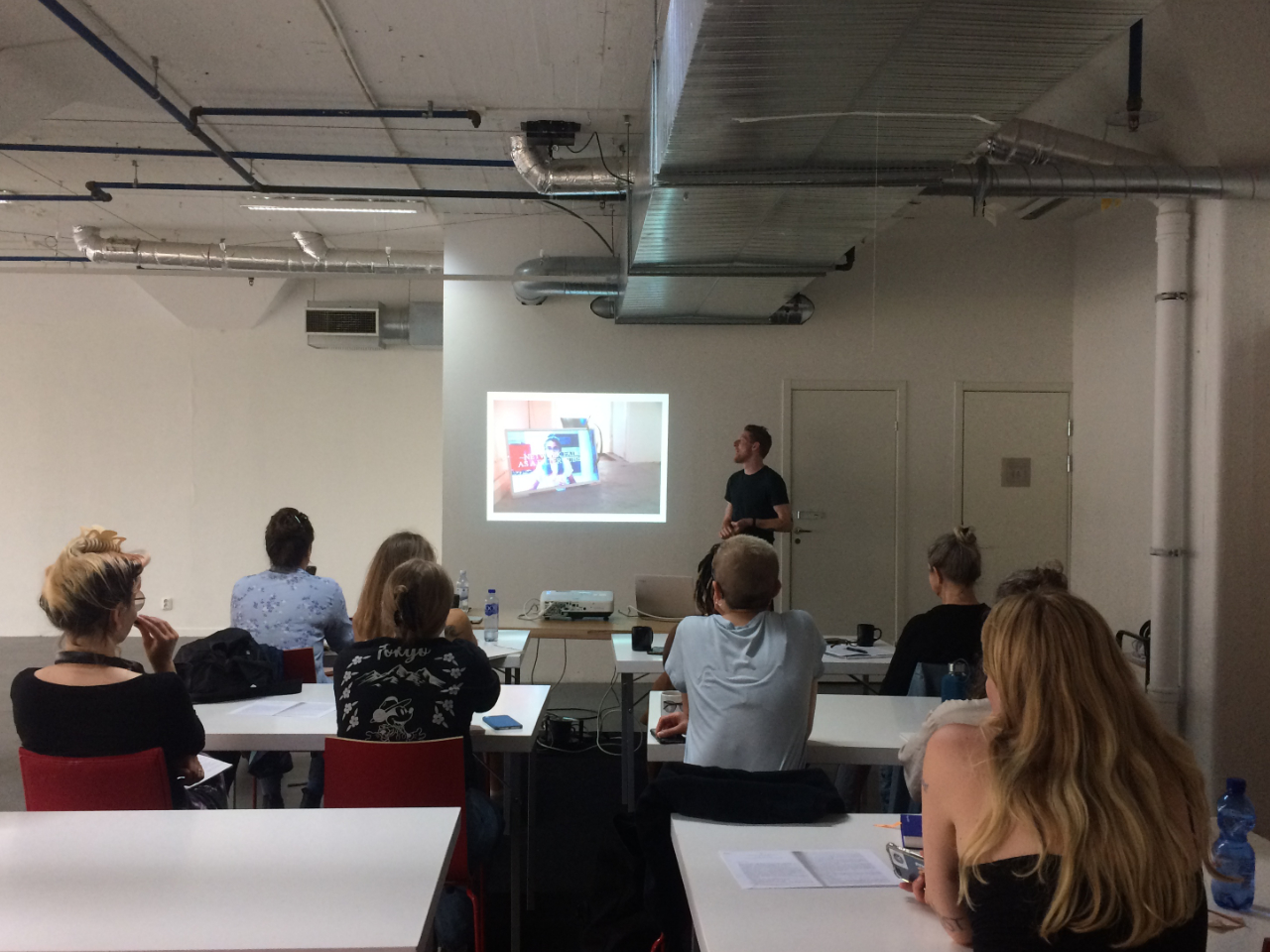
Ephemeral Care presentation at Konstfack, Stockholm. Image: Alice Máselníková
It's only really as you travel around Sweden in a car or train and go actual distances that you realise how big it is. I live in Göteborg - South-West Sweden - and travelled to Stockholm, roughly in the middle of the country. The express train (a mere 4 hours) tracks a diagonal line across the country taking in the pastoral Swedish equivalent of the American Mid-West; big Skys, big farms and big religion with the nordic edition of big lakes. Coming from the UK, where everything is on top of each other and even the “wild” places are realistically only an hour or so from major cities Sweden is a contrast. I didn’t go anywhere near the wilds of Sweden, I didn’t even leave the populous south of the country, but my days it is big. It’s big and it’s spread out.
Stockholm, 10.30 AM. Metro to Telefonplan. Phone call with KKV (artist-run studio, workshop and exhibition space in Göteborg) to discuss building permissions whilst pacing outside Galleri Konstfack. Inside, Alice Máselníková; artist, curator, project-manager, educator and a woman seemingly blessed with boundless reserves of drive (ARNE/Flat Octopus/AIM/Supermarket/Intercult/Woven Network), is leading a class about administrative processes in the arts as part of the course she and Andreas Ribbung (Candyland/ARNE/Supermarket/AIM) run at Konstfack. The course focuses on providing participants with the tools to build an artist-run initiative from the ground up. The culmination of the syllabus sees the groups newly birthed initiative present at Supermarket - Stockholm Independent Art Fair in Stockholm in October 2021. It's a super cool and needed model that is to my knowledge the only one of its kind in Europe right now (NODE have an online version but there is less real-life output or focus on group collaboration). I am here at Alice’s invitation to present Ephemeral Care to the group and share some of my own experiences in the Wild West of artist-led.
But first, lunch.
Lunch is always welcome after a long journey. Myself, Alice and a couple of the students go for Vietnamese food. We chat about the relative merits of East Asian food versus Turkish, museum dates, Jeremy Till’s book Architecture Depends and the notion of the role of temporality and the human in architectural design, recapping the morning's lecture and thinking ahead to the student's aspirations for Supermarket. It's fun and light and refreshing, all the things I’ve missed from art trips the past couple of years.
Coffee. Presentation. My main role with EC if, we are being honest, is the clown. I’m not academically gifted particularly, I don’t have a PhD or that much interest in rereading Deleuze & Guitari to sift out new layers of meaning. I am quite good at talking at people for periods in a lightly amusing manner though, and that is what I did here. I even do funny movements it seems (see the image below - yes EC is available for weddings and birthdays). I present Ephemeral Care and its aims and plans, talk a bit about where we came from (artist-run gallery HUTT in Nottingham) and expound my vision for the future of artist-run. It was interesting reflecting on HUTT in this environment. When we (me, Ciarán Harrington and Rebecca Scofield) started HUTT, fresh out of our BA at Nottingham Trent University in 2014 we had absolutely no idea what we were doing. We didn’t have the benefit of a course to teach us how to do it despite the fact we had just spent three years ostensibly learning how to “do art” and “work within a creative field”. It was nice for me to be able to stand in front of this group of humans, excited to start their own artist-run journey and tell them it doesn’t matter if you fuck up; in fact, appreciate that you will fuck up. We made a lot of mistakes with HUTT, both whilst it was the original crew, and after Ciarán and Becky had left and Connor Brazier (of this parish) came on board. At the same time, we worked hard, learned from our mistakes and developed how we were working eventually becoming something quite good if I do say so myself. The fucking up needs to be seen as a generative and educative experience, not something to be terrified of.
So here is take away #1 from Stockholm: don’t be afraid to fuck up - just learn from it and “own it” as they say.
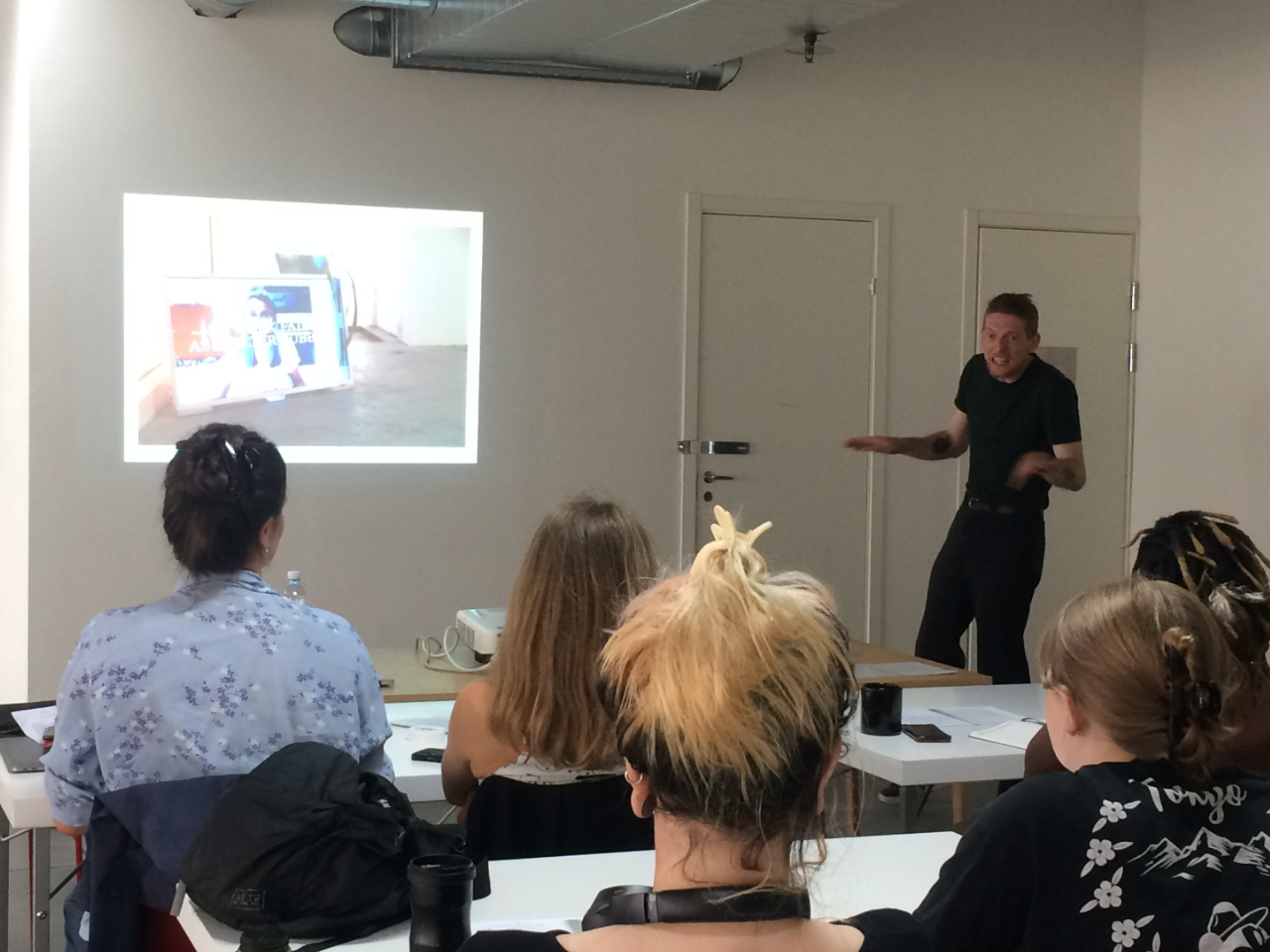
Ephemeral Care's Joe Rowley presenting at Konstfack, Stockholm. Image: Alice Máselníková
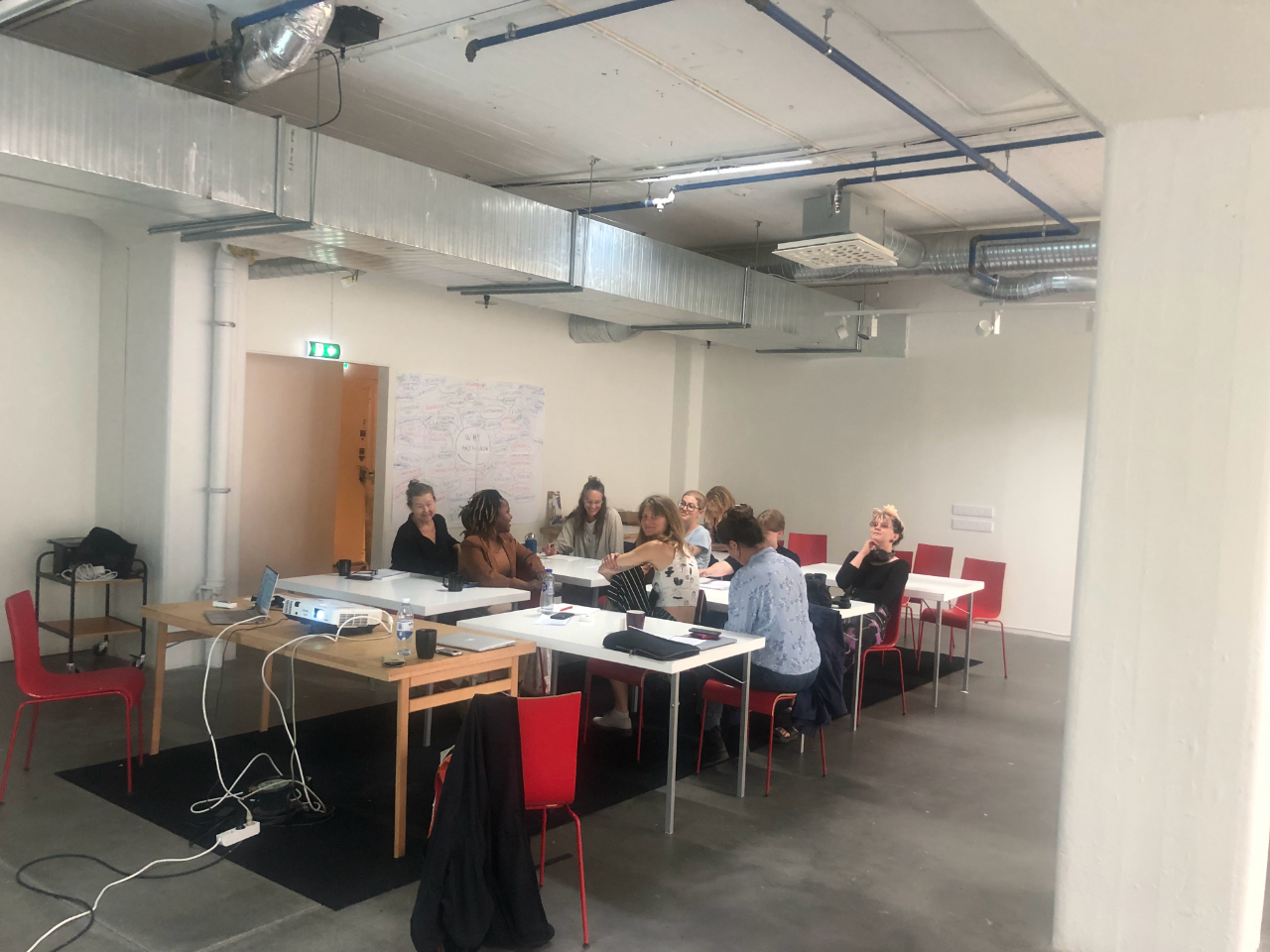
Students at Konstfack, Stockholm. Image: Joe Rowley
After the session finished Alice and I went for a beer. Alice is a remarkable woman who keeps a whole dinner service of plates spinning from an arts organisation perspective across a range of large scale projects whilst still managing to collaboratively run a super fun and nimble artist-run curatorial project, Flat Octopus and somehow maintain an artistic practice as a painter. We chat about projects and plans and our respective backgrounds.
Alice is from the Czech city of Zlín in Eastern Moravia. The city is a fascinating example of collaborative and communicative building, having basically been totally developed by the Bata shoe company as a workers city. Whilst one might immediately jump to the notion that this occurred during the Communist era in Czechoslovakia (one could be forgiven for mistaking the architecture for Soviet-inspired) the city Functionalist design developed in the interwar years. It is a rare example of a cooperation/business owner taking a deep interest in the care of their community and workers outside of maintaining a cheap and localised workforce. Perhaps her roots in this community have inspired Alice’s interest in collective-run projects and impact her perspective on artist-run initiatives in some subconscious way.
Alice had to get off to her next engagement, moderating a digital tour of Odin Teatret in Denmark with artist Elena Flores via Zoom for Woven Network which highlights the work of female artists in the Nordic region. We took a slow walk through Södermalm with Alice pointing out the various artist's studios, project spaces and galleries along the way, all closed for the summer - a bizarre Swedish insistence.
The next day had a more reasonable start time. 8 AM in Södermalm is surprisingly quiet, at least in July. Perhaps it's the aforementioned Swedish insistence on the whole country closing for three months over the summer, my having only ever been in Stockholm in the winter before and the 26-degree-blue-sky feeling pleasingly Mediterranean, but it was very tranquil. I took a stroll through the sunny streets of the island, known for its hip nightlife and home to a number of the city’s artist-run initiatives, finally settling in at Lykke to plan my day.
First stop. Index:
Indexis great. A super forward-looking institution with a great director in the form of Martí Manen. The current exhibition for my visit was Hanni Kamaly’s THE MIGHT THEY HAVE (NEVER UNDONE), a group of precarious, triffid-like skeletal sculptures which confront the viewer as soon as they hit the gallery floor, accompanied by a series of four video essays. The videos present various narratives exploring the complex relationship Sweden has to its colonial past, colonial present, role in the establishment of taxonomy and generally exploring the "enduring lineages of power exerted through systems of oppression” 1. I was the only visitor on arrival. The space had only just opened for the day and I enjoyed a private tour with Isabella Tjäder. We were joined by Sara Rossling (independent curator and director of Nordiska Konsförbundet) and the three of us chatted about various upcoming projects, vacation plans, the biennials in Borås and Göteborg and agreed that the art walk was the new video essay.
Kamaly’s exhibition was a real breath of fresh air for me. Despite the context of this autumn's edition of GIBCA (Gothenburg International Biennial of Contemporary Art) focusing on post-colonial narratives and uncovering hidden histories in a city shaped by its relationship with the Americas and Sweden’s colonies in West Africa and the Caribbean, few of the works that I have encountered so far had the same impact and clarity as Kamaly’s presentation. For me, the combination of imposition and creature-like sculptures and dense, layered yet intimate video essays found something deeper and more real as a contribution to the discourse than anything other than Hira Nabi’s video All that Perishes at the Edge of Land in the current GIBCA offering.
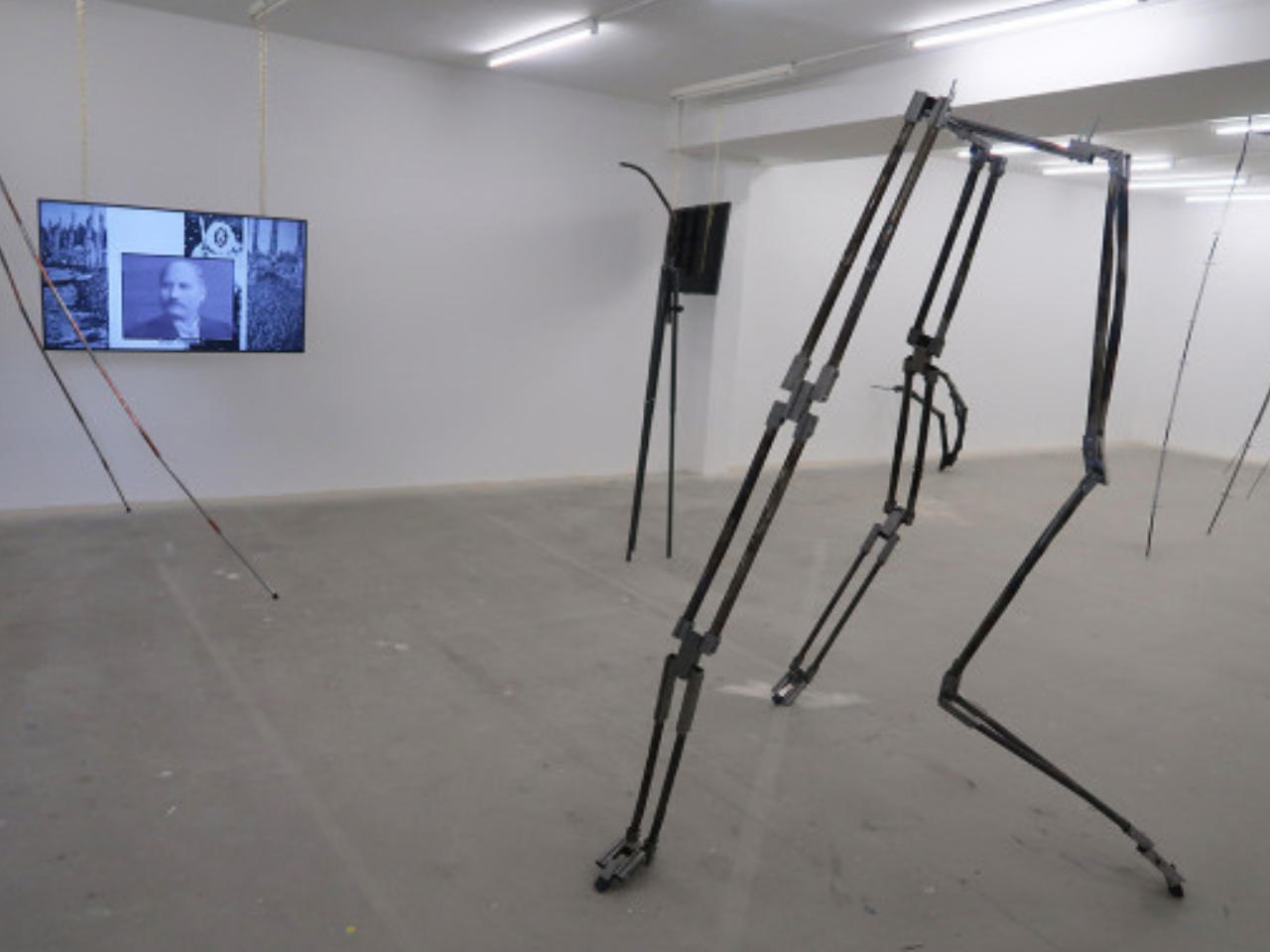
Installation shot of THE MIGHT THEY HAVE (NEVER UNDONE) by Hanni Kamaly at Index, Stockholm. Image: Index Stockholm
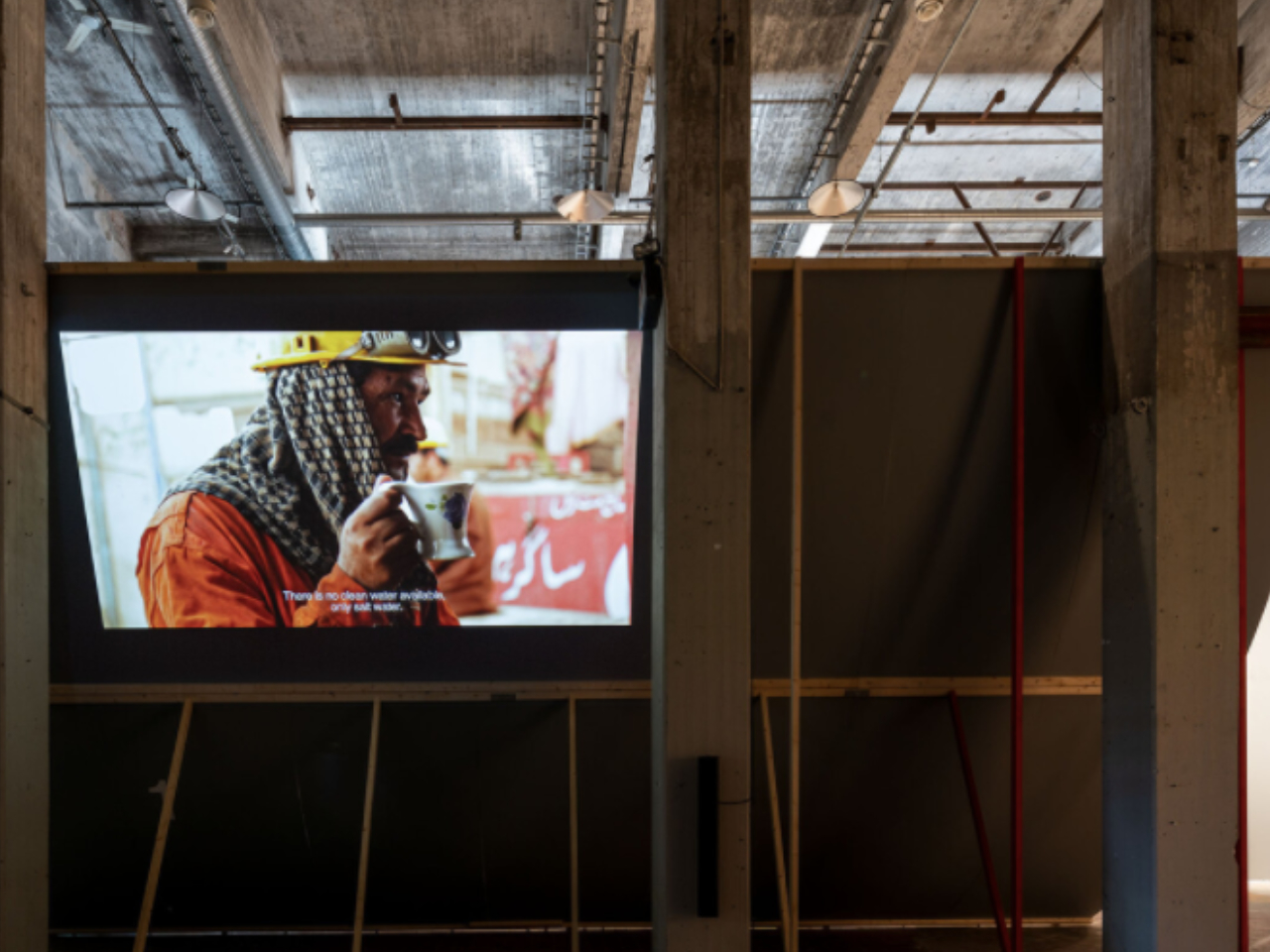
Installation shot of All that Perishes at the Edge of Land by Hira Nabi at Röda Sten Konsthall; göteborg for GIBCA 2021 - The Ghost Ship and the Sea Change. Image: Gothenburg international Biennial of Contemporary Art
NEEEEXXXT. Lunch:
I lost track of time at Index and had to make a dash for T-centralen to get the metro up to Odenplan and then get lost twice on the way to Pascal to meet Tal Gilad.
I met Tal as a contributor for The Exhibition is in Transit (text here) but through the editorial process, we have become friends. Pascal is nice, a bit big city for my liking (no laptops allowed and everything costs probably twice what is reasonable) but boy do they do a good Ceaser Salad. Tal and I chat about The Exhibition is in Transit and upcoming projects - Tal and Isabella are working together on something it transpires.
Alcohol and the instance on parting as part of the role of an art professional's activity is something I think I’ll be writing on in the future, but one thing I will say here is that finding solidarity with others in the industry and providing support for one another is so important, and also was such a wonderful feeling. I don’t know if I expressed it well enough at the time to Tal because it's so unfamiliar to me to be encountered by the honesty and support she showed, but it was so appreciated.
Take away #2 from Stockholm: support your colleagues and friends, accept them as the faulted humans they are and help them to be the best version of themselves. This is something I’ve thought for a while anyway but, I think sobriety has really highlighted the fact that a lot of the mistakes I’ve made in my career (and life) so far have been because of poor diversions made whilst under the influence of drugs and alcohol or, and maybe especially, because of the emotional and physical fallout from that. I wouldn’t have got out of it without support from my friends and I encourage anyone else to seek that support if they need it. There are a lot of organisations out there for this and not all of them are group/religious based.
Tal and I finished lunch and took a circuitous stroll through the early afternoon heat to Detroit Stockholm.
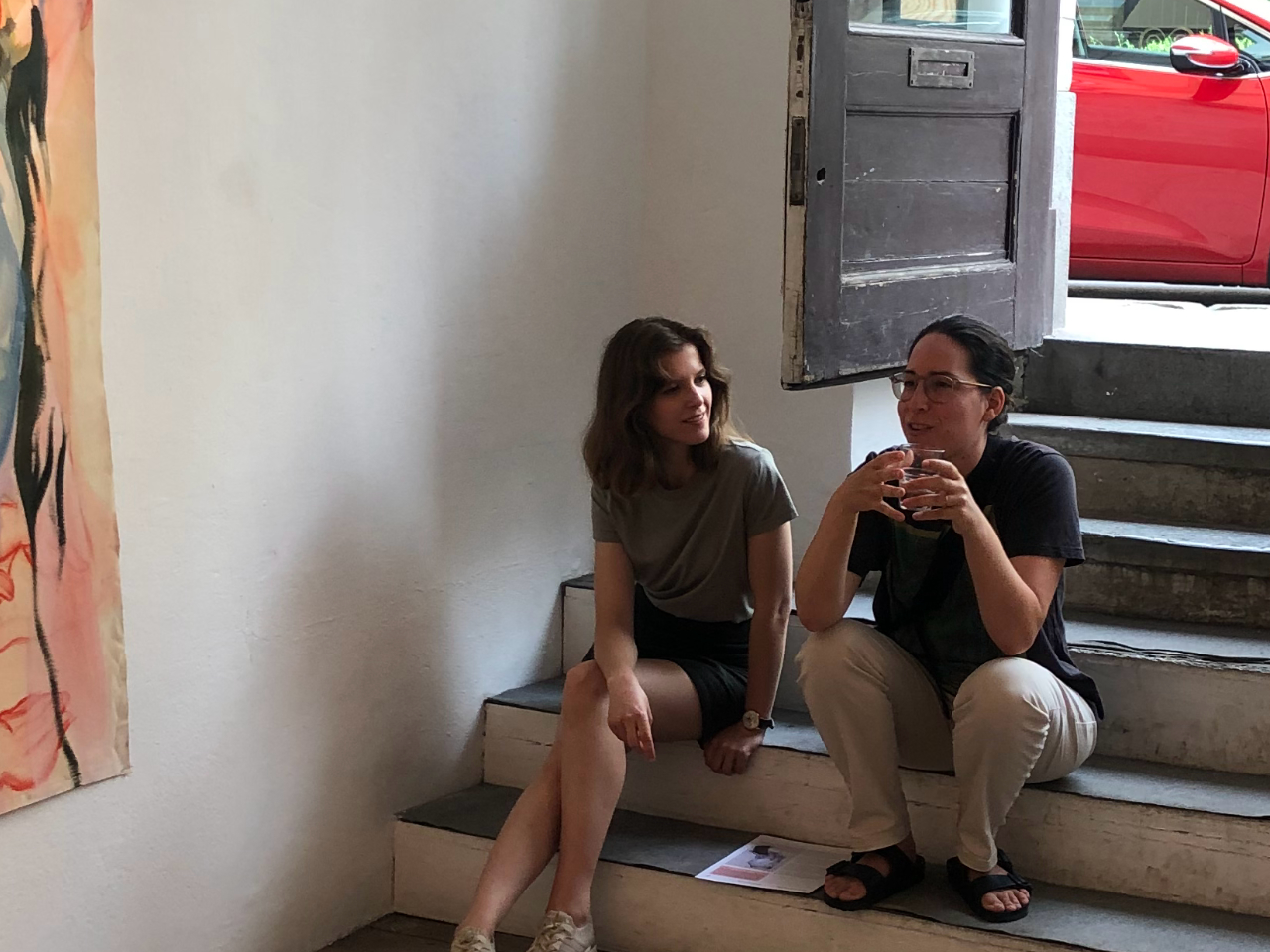
Alice Máselníková and Tal Gilad at Detroit. Image: Joe Rowley
Stop 2. Detroit Stockholm
Alice was waiting for us at Detroit to show us Flat Octopus’ exhibition that was being hosted there. Flat Octopus is a collective comprised of seven members. The concept focuses on working with apartment exhibitions with members taking turns to invite artists, hosting them in their apartment and producing an exhibition. The show we saw, The Rapture of the Sisters, had been arranged by Alice and featured Irish painter Sian Costello (British readers may remember her from the TV show Portrait Artist of the Year). The works were beautiful and powerful taking inspiration from Rubens painting ‘The Rape of the Daughters of Leucippus’ (1618). They consider the prevalence of violence against women in Western mythology, recasting the smooth baroque beauty, eroticism and idealisation of this violence in Ruben’s work through dynamic, expressive and performative technique. I loved Sian’s work on the TV and it's even better in person I must say, so this was a treat. Alice then took us on a brief tour of Detroit’s studios.
Detroit has both a street-front gallery space and a studio complex hidden, rabbit warren-like in the back. It provides a free platform for both members and applicants to exhibit. It had been a long time since I had been in a studio like Detriot. It conjured memories of Manchester or Nottingham with a maze of seemingly overlapping spaces and detritus and cross-pollination. Tal had a lengthy chat with Daniel Ankerstrand, who makes beautiful leather products out of tanned fish skin whilst Alice and I poked through the spaces of Hanna Stansvik and Fritz Østeb.
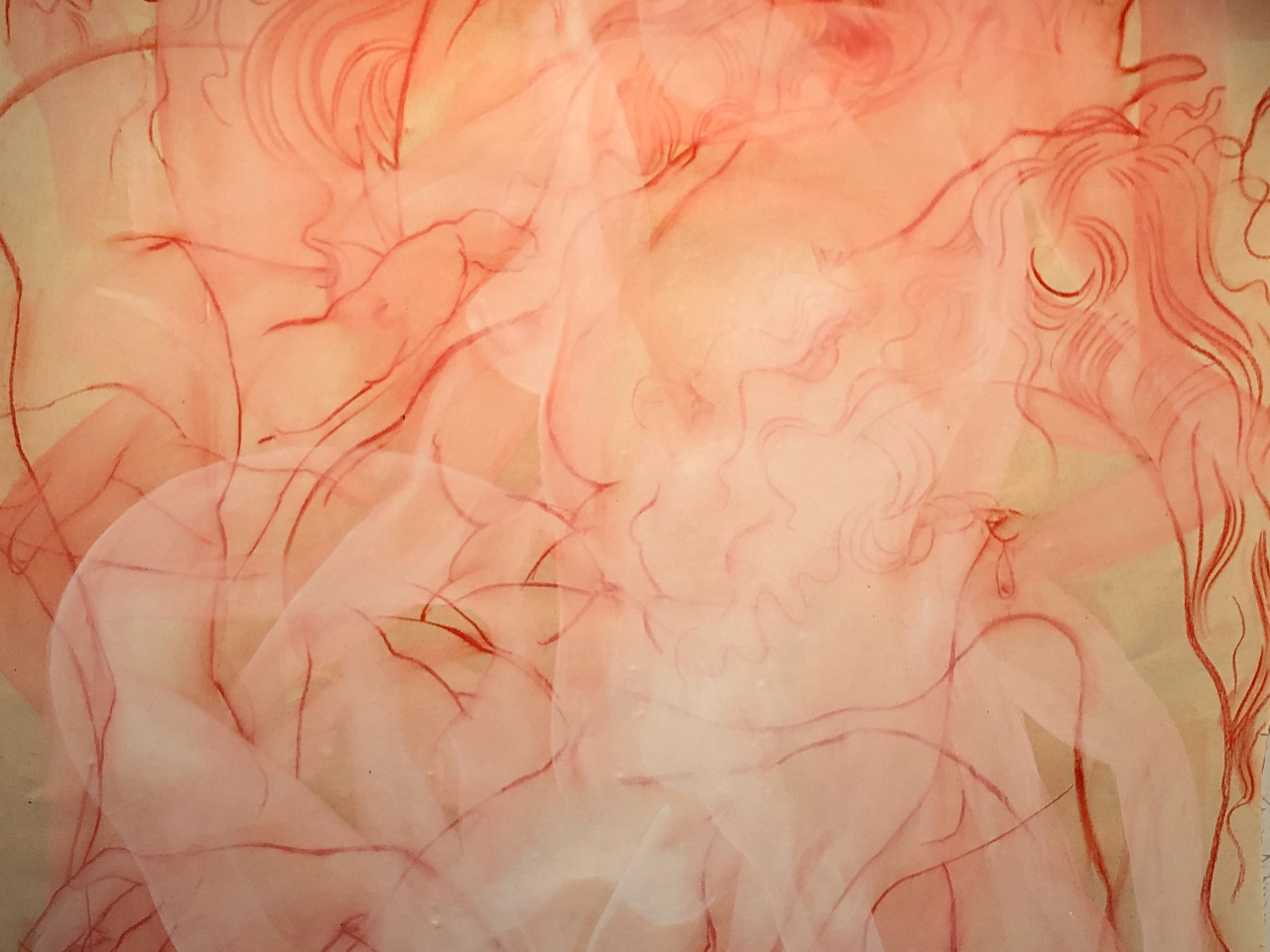
Close up of one of Sian Costello's works in The Rapture of the Sisters, presented by Flat Octopus at Detroit, Stockholm. Image: Joe Rowley
Alice had to shoot off again after Detroit and Tal and I went for ice cream.
Stop 3. ID:I
My final meeting for the day was with Annelie Wallin and Snežana Bohm at Galleri ID:I. ID:I was back on Södermalm and has been a staple of the Stockholm artist-run scene for nearly 20 years. The gallery is run by a board of members who get the opportunity to show their work or give up their spot to an invited guest every couple of years. The structure works pretty well from what Annelie and Snežana explained and the organisation is dedicated to bringing in emerging artists as older members move on, keeping the seven refreshed. It made me think back to something that I had said to Alice’s student the day before…
Take away #3 from Stockholm: When initiating an artist-led project it is useful to have a couple of structural tenants that you base your decisions on. With HUTT we had three broadly speaking: 1) Work with artists based outside of Nottingham to bring new ideas into the city. 2) work with emerging artists. 3) give first solo exhibitions to artists. Having this very simple and broad framework helped us in making a lot of our decisions. It also assisted in keeping the organisation moving in a direction we were happy with.
The commitment showed by ID.I in keeping the Stockholm scene moving forward is going to be celebrated in 2022 for the project’s 20th birthday so keep an eye out for that one!
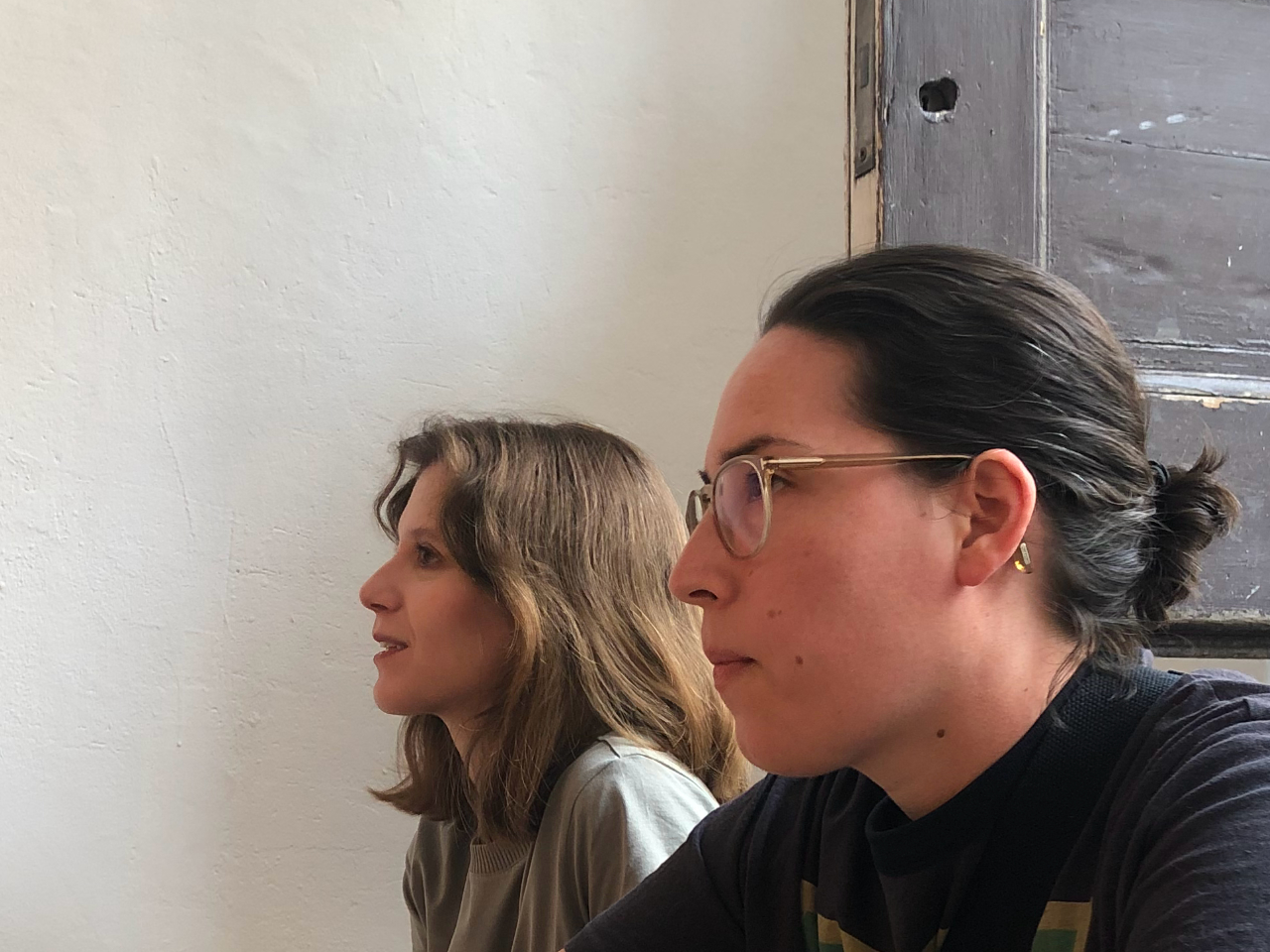
Alice Máselníková and Tal Gilad at Detroit. Image: Joe Rowley
I’ve never been a big fan of Stockholm in the past. Granted I had fun the first time I was there (18 years old and drunk for 4 days) but there has always been a sense of stress and tension there that I haven’t appreciated. This time it was the opposite. It was relaxing and expressive and dynamic and I met a bunch of fantastic people. It was everything you want from these art/business trips. Making trips like this and firing connections is exactly how artist-run communities grow. Sweden is big and there is a gap, physical and social, between Göteborg and Stockholm in a lot of ways. Lessons from the capital can be brought to Göteborg however and the same is true in the other direction. Most importantly though that gap needs to close. Improving the links and communication and collaboration between the major cultural hubs in Sweden (Stockholm, Göteborg, Malmö and Umeå) can only help what has the potential to be a hugely productive space for artist-run. Without support for one another through the asset-stripping of culture funding by an increasingly right-leaning government will follow that of many other Western European nations leaving what is a very good situation uncapitalised on in a hole it may struggle to get out of.
Take away #4 from Stockholm: I’ll be back soon!
*
Big thanks to Alice Máselníková, Tal Gilad, Isabella Tjäder, Sara Rossling, Annalie Walin and Snežana Bohm for taking the time to meet and chat and to all of you for being great!
(1) http://indexfoundation.se/exhibitions/hanni-kamaly-the-might-they-have/hanni-kamaly-the-might-they-have
ESSAY
Joe Rowley - July 2021
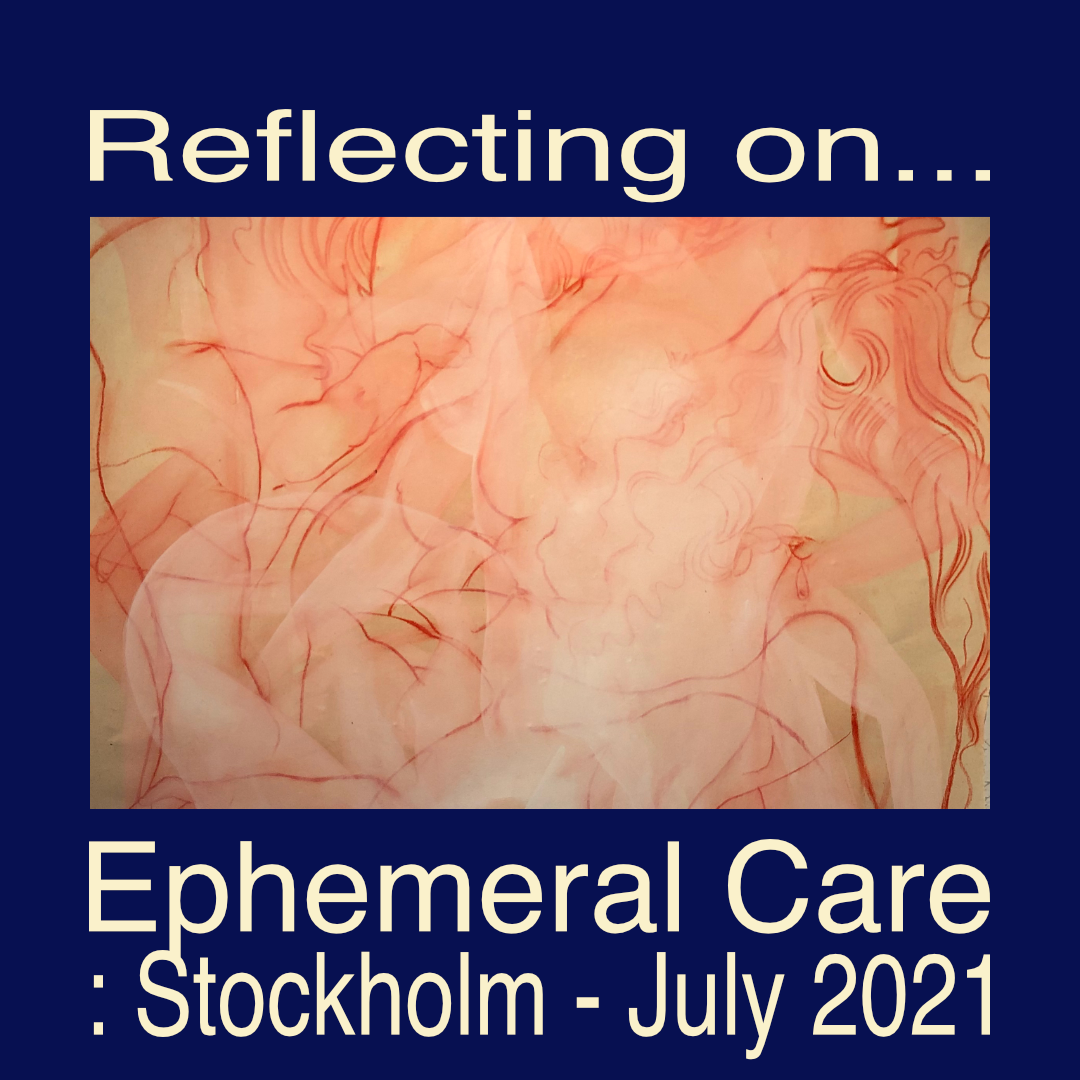
The Reflecting on... series takes situations, objects, artworks, articles, texts, podcasts and anything else really as starting points for reflection on artist-led and self-organised (AL&SO) practice.
Ephemeral Care focuses on ethics, practice and strategies in artist-led and self-organised projects.